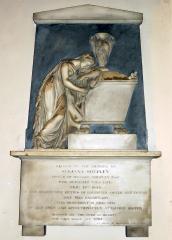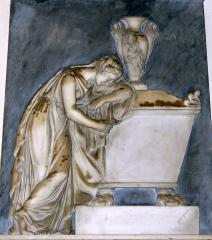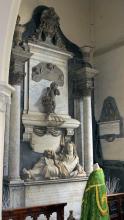

Susanna Shepley, d.1840, by Edward Physick.
Susanna Shepley, d.1840, by Edward Physick.

This monument is not a spectacular one, or a famous one or a particularly large one, but I like it as an example of a type: the Classical girl leaning against a tomb, depicted in high relief. It shows many of the characteristic features of the more elaborate wall panels of the early 19th Century.
We start with the girl herself. She is Classically draped, with a long garment down to her feet, caught high above the waist by a cord under the breasts, a rather thin fabric which shows to advantage the shape of torso and limbs beneath, accentuated by the folds. Over this, she wears a cloak of heavier stuff, which hangs in graceful folds behind, and is massed up under and around one arm. Her pose is leaning, mourning against the tomb, her head bowed over the arm on the tomb itself, her other arm reached out, pulling the drape from the front of the casket. All Greek enough, and being in Classical style, she is expressionless rather than looking sad. Her legs are casually crossed, in the casual rather than respectful stance typical since the 18th Century in apparently mourning tomb figures. The pose looks unstrained, but if you stand in this fashion, with feet at right angles as depicted, it is not so comfortable. The girl’s physique is statuesque rather than particularly slender, with some muscularity to the arms, which is right for the Classical figure, though the visible shoulder is somewhat sparse of muscle, and with her face having a mix of Victorian and Classical features, in a pleasingly attractive combination. Who is she? Not an allegorical figure, nor the deceased, but ‘her only and affectionately attached sister’ referred to but not named on the monumental inscription beneath.
The tomb she rests on is a casket tomb, with outward-angled sides, and a lid, with a central pot and at the corners, acroteria, the ‘ears’ on the sides of a pediment or lid – we can only see the one here – and the design, with stylised anemone ornament, is very typical. In the centre of the tomb is a tall, Classical pot, evocative of the funereal urn, here encircled with a wreath of leaves and small flowers, and with its handles carved as swans (more swan sculpture on this page). The base of the casket tomb is supported on little feet, carved as lion feet, which is again a frequently found embellishment, including on outdoor casket tombs in churchyards.
The whole scene is against a dark backing panel, with a further bit of white marble at the top cut to pediment shape, and a shelf at the base, which serves to divide off the lower part of the monument, which is the inscribed panel to Susanna Shepley, who died in 1840. There are two blocky supports at the very base, and one of these is signed on the side by the sculptor, E. Physick.
White-on-black panels are the staple type from about 1800, when the supplies of foreign, coloured marble dried up due to the Napoleonic wars, not to reappear much in monuments till nearly 100 years later. There are more such panels in English churches than any other sort, and range from the simplest cut and uncarved panels through to charming figure pieces such as this one. Indeed, this is rather a late example, and although there are plenty of marble girls and tombs from early Victorian times, they are most frequent from the beginning of the Century, and the last decades of the 18th Century, being gradual descendants of the more ornate and flamboyant allegorical and representative carved statues of the great and the rich of previous generations.
The sculptor, Edward Physick, refers to one of a family by that name, a veritable dynasty of sculptors and monument makers, exhibiting between 1818 and the early 1870s. The first name was generally Edward, thus we have Edward Gustavus Physick, Edward James Physick Senior and Junior, and Edward William Physick, to whom this monument is attributed. There were also Robert Physick, Charles Physick, Sidney Herbert Physick, and William Physick, all sculptors too, and at least two painters.
Carshalton Church has a number of monuments within it, including a couple of other figure panels, and the grand figure piece to Sir William and Dame Mary Scawen (picture below) - see this page.
 The grand Scawen monument, and another small figural piece, in the Church.
The grand Scawen monument, and another small figural piece, in the Church.
This page was originally part of a 'sculpture of the month' series, for March 2016. Although the older pages in that series have been absorbed within the site, if you would wish to follow the original monthly series, then jump to the next month (April 2016) or the previous month (Feb. 2016). To continue, go to the bottom of each page where a paragraph like this one allows you to continue to follow the monthly links.
Introduction to church monuments
Visits to this page from 1 Mar 2016: 3,995